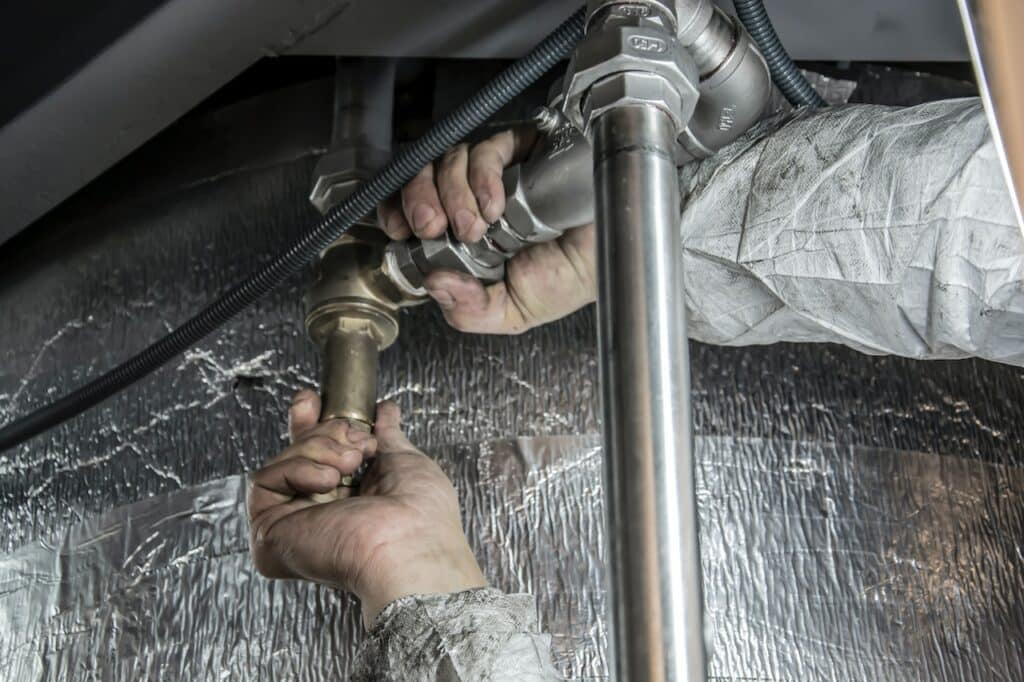
From bothersome leaky faucets to the more urgent burst pipes and sewer line backups, this article serves as a comprehensive guide to help you identify, troubleshoot, and often resolve these common plumbing challenges. By knowing how to handle these issues, you can save both time and money, while ensuring the smooth and efficient operation of your home’s plumbing system.
Clogged Drain:
A clogged drain is a common nuisance in households. It often occurs in sinks, showers, or toilets due to a buildup of hair, soap scum, or debris. To fix this issue, start by using a plunger to create pressure and dislodge the blockage. If that doesn’t work, a drain snake or a homemade solution of baking soda and vinegar can be used to break down the clog. If the problem persists, it’s advisable to contact a professional plumber who can employ specialized tools to clear the drain effectively.
Leaky Faucet:
A leaky faucet is not only irritating but also wasteful. The most common cause of a leaky faucet is a worn-out washer or O-ring. To fix it, turn off the water supply to the affected faucet and disassemble it to access the faulty part. You can then replace the washer or O-ring with a matching replacement. Ensure that all components are properly reassembled to stop the leak. If you’re uncertain about the repair, consult a plumbing expert.
Running Toilet:
A running toilet can be both bothersome and costly in terms of water usage. The usual culprits behind this issue are a faulty flapper or fill valve. You can fix it by adjusting the chain that connects the flush handle to the flapper or by replacing the flapper if it’s worn. Alternatively, you can adjust the water level in the tank to stop the constant running. Regular maintenance and prompt repairs can save you water and money.
Low Water Pressure:
Low water pressure can make daily tasks like showering and doing dishes frustrating. To fix this problem, start by cleaning the aerators on your faucets and showerheads. These can accumulate sediment and reduce water flow. Additionally, check for leaks in your plumbing system, as they can also contribute to low pressure. Ensure that the main shut-off valve is fully open, and if the issue persists, consider replacing old or corroded pipes that may be restricting water flow.
Burst Pipe:
A burst pipe is a plumbing emergency that requires immediate attention to prevent water damage to your home. If a pipe bursts, the first step is to shut off the main water supply to stop the flow of water. Then, carefully identify the damaged section of the pipe, cut it out, and replace it with new pipe and fittings. It’s essential to act quickly and accurately in this situation to minimize potential structural damage and flooding in your home. In cases of severe pipe damage, consult a professional plumber to ensure a proper fix.
Water Heater Issues:
Problems with your water heater can disrupt your daily routine, from having no hot water to dealing with unusual noises. When your water heater acts up, begin by checking the thermostat settings to ensure they are at the desired temperature. If the water heater runs on gas, make sure the pilot light is lit; if it’s an electric heater, verify that the circuit breaker is functioning correctly. For issues like leaking pressure relief valves, consult your user manual for adjustment instructions. For complex problems, it’s best to call a professional plumber or water heater specialist to diagnose and repair the issue.
Toilet Clog:
A clogged toilet can cause inconvenience and frustration. It’s often due to the improper disposal of items that shouldn’t be flushed. To fix this issue, start by using a plunger to create suction and dislodge the blockage. Ensure you have a good seal with the plunger over the drain hole. If the clog is severe and the plunger isn’t effective, consider using a toilet auger, which is designed to reach deeper into the drain and break up stubborn clogs. If all else fails, contact a professional plumber who can diagnose and resolve the issue.
Sewer Line Backup:
A sewer line backup is a more severe plumbing issue that can cause a wide range of problems in your home. If you notice multiple drains backing up at the same time or sewage coming up in your drains, it’s a sign of a sewer line issue. For minor clogs, you can attempt to clear them with a sewer snake, following manufacturer instructions. However, if the problem persists, or if you suspect tree roots or significant damage to the sewer line, it’s crucial to call a professional plumber. Attempting to address a major sewer line issue on your own can lead to more extensive and costly problems.
Frozen Pipes:
In cold climates, frozen pipes are a common concern during the winter months. When you discover frozen pipes, it’s essential to thaw them as soon as possible. Start by locating the frozen section, which is often near an exterior wall or in unheated areas. Thaw the pipe slowly using a safe heat source like a hairdryer, heating tape, or warm towels. Never use an open flame or high-temperature heat sources as they can damage the pipes. Prevent future freezes by insulating exposed pipes and allowing a trickle of water to run during extremely cold weather to keep pipes from freezing.
Water Line Leaks:
If you notice water seeping through your walls or foundation, it’s a sign of a water line leak that requires prompt attention. First, shut off the main water supply to prevent further water damage. Then, call a professional plumber to assess the extent of the damage and the location of the leak. Repairing a water line leak often involves excavating the affected area, so it’s a job best left to a licensed plumber who can accurately diagnose the issue and make the necessary repairs to prevent future leaks and water damag